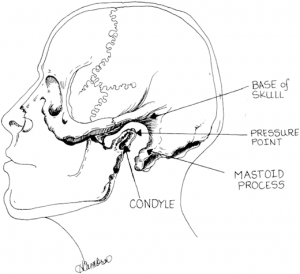Laryngospasm
Background
- An uncontrolled or involuntary muscular contraction of the vocal folds.
- Reflex is normally triggered when the vocal cords or the area of the trachea below the vocal folds detects the entry of water, mucus, blood, or other substance.
- Associated with ketamine (0.3%)
- Usually associated with large doses or rapid IV push
Causes
- Ammonia toxicity
- Medications
- Hypocalcemia
- Acute tetanus
- Ludwig's angina
- Acute laryngospasm
- Submersion injury
- Pulmonary chemical agents
- Pepper spray
- Smoke inhalation injury
- Caustic cocktail
Clinical Features
- Apnea may be the only sign in complete closure
- Partial closure can manifest as stridor, guttural noises, and paradoxical chest movement
Differential Diagnosis
- Oversedation
- Failure of respiratory drive
Evaluation
Workup
- Typically not indicated
Diagnosis
- Typically a clinical diagnosis
Management

Apply pressure inwardly and anteriorly to the point labeled "Pressure Point" (Larson's Point) while applying a jaw thrust to relieve laryngospasm [1]
- Jaw thrust
- Place pressure on Larson's notch
- If jaw thrust and pressure are not sufficient, bag valve mask with PEEP
- If above do not resolve laryngospasm, sedate more deeply (propofol is the traditional choice, 0.5mg/kg)
- If deeper sedation does not resolve laryngospasm, paralyze and intubate
- In pediatric patients, consider gentle chest compressions
Disposition
- Observation for 2-3 hours after resolution for development of post-obstructive pulmonary edema, bradycardia (consider atropine), or aspiration
See Also
Airway Pages
- Pre-intubation
- Induction
- Intubation
- Surgical airways
- Post-intubation
External Links
References
- ↑ Larson CP Jr. Laryngospasm--the best treatment. Anesthesiology. 1998 Nov;89(5):1293-4. doi: 10.1097/00000542-199811000-00056. PMID: 9822036.






